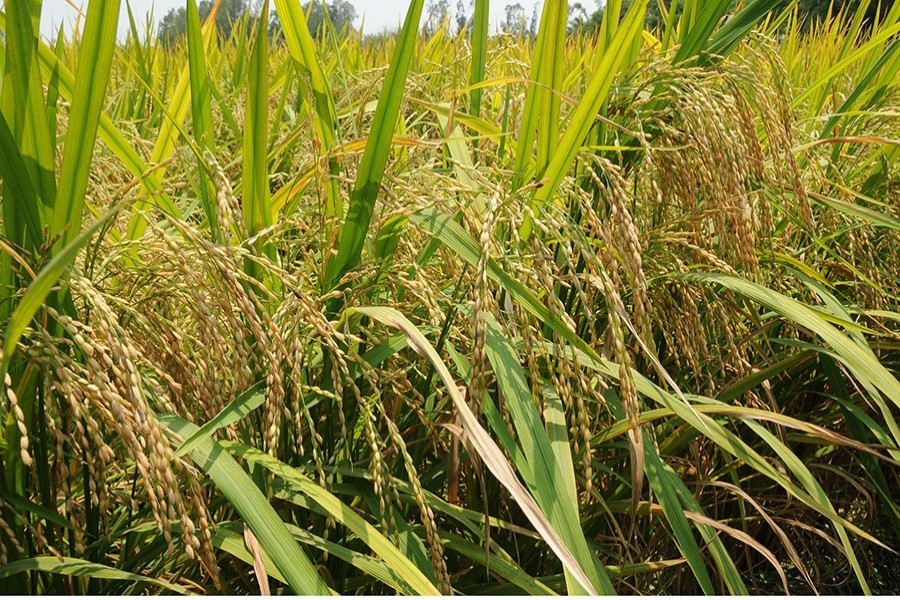
Published :
Updated :

Director (Administration) of Bangladesh Institute of Nuclear Agriculture (BINA) Dr Mirza Mofazzal Islam developed a new salinity and submergence tolerant rice variety named BINA Dhan-23.
This rice plants are able to live on in submerged fields up to 15 days. At the eighth meeting of the National Seed Board, the variety was approved for cultivation at the farmers' level. This variety is suitable for cultivation in Aman season in the tidal, saline and flood-prone areas.
Climate changes due to global warming ultimately causes adverse effects in the country's agriculture. Bangladesh is one of the countries where the risk of climate change is high because of sea level rise and thus the probability of cyclone increases.
According to a report on the environment of Bangladesh, the sea surface can rise up to 1.0 meter by 2050. As a result, about 3,000 million hectares of land would be permanently lost and overall production could be reduced by about 30 per cent.
The total cultivable land in the country is about 1.40 billion hectares, among 1.0 million hectares of land are saline area and 2.6 million hectares are submerged land.
Rice production is likely to decrease due to sudden floods and increased salinity in various regions, especially coastal areas such as Satkhira, Bagerhat, Khulna, Barisal, Barguna, Bhola, Patuakhali, Jhalakathi, Pirojpur, Feni, Lakshmipur, Noakhali, Chattogram and Cox's Bazar.
Due to tides and cyclones, the cultivable land is constantly being saline as sea salt water enters into agricultural land, especially paddy cultivation is severely disrupted.
It is reported that rice is not cultivated in the areas where salt concentrations is high. The scientists believe if this large amount of fallow land is brought under rice cultivation, the country's food deficiency will be greatly reduced.
In Bangladesh, different cultivated rice varities during the Aman season are regularly affected by various adverse conditions.
The low to medium high lands of this country, which account for 20 per cent of the total land, are completely submerged by floodwater during the monsoon.
Its duration usually lasts from one to three weeks. As a result, the yield of paddy is partly or completely affected by the severe flood.
In order to compensate a huge financial loss, the farmers used to prepare new seedbed or to transplant aged seedling of old seedbed. That ultimately causes lower production and investment of money and labour burden of the farmers.
Many farmers are unable to transplant seedling due to lack of seedlings and financial distress and thus their land remain fallow.
As a consequence, every year the government has to spend lot of money on agricultural rehabilitation.
Flood and salinity both problems exist in the coastal areas. Under the circumstances, there is a need to develop a new high-yielding, saline and submergence tolerant variety.
In order to face these challenges, BINA has developed a variety that can tolerate salinity up to 8.0 ds/m and is able to produce normal yield even if submerged for up to 15 days.
Farmers in the southern and flood-prone areas are losing interest in rice cultivation due to the tidal salinity and sudden flash flood. In the country every year there are millions of hectares of land are kept underutilised because of harsh environments.
BINA has developed salinity and submergence tolerant rice variety that are cultivated in those areas under the guidance of chief scientific officer of the Plant Breeding Division.
The breakthrough came from Dr Mirza Mofazzal Islam's six-year-long study, research and efforts. The researchers said the new variety of rice will give hope to the farmers. The flood-prone areas, including Satkhira, Bagerhat, Khulna, Barisal and this fallow land will be expanded as rice growing area.
The new rice grain is medium and has a higher yield per hectare (5.5 tonnes). Therefore, farmers can benefit from cultivating this variety without any risk.
The leaf of the variety is dark green, flag leaf erect, stems, leaves and shoots are very strong, no 'lodging' tendency even in the windy air, non-shattering, the colour of ripened rice is normal golden colour, rice grain is medium-sized, non-sticky and tasty.
If in the next few years, by extension of this variety, about 1.0 million hectares of salinity and 2.6 million hectares of submerged-prone area of Aman rice can be brought under cultivation of about 0.7 million to 1.0 million hectares of land.
It is expected that extra 2.0 million to 3.0 million tonnes of rice can be produced in the areas.
This variety will help to produce more rice that will ultimately contribute to the country's food security.
Dr Mirza Mofazzal Islam said BINA Dhan-23 has two qualities - salinity and submergence tolerant. This variety has the capacity to grow in saline and flash flooded area up to 15 days in submerged condition, he added.
In the southern area where the chance of salinity and flash flood is very high, Dr. Islam strongly recommended Binadhan-23 to encounter this challenge. In co-operation with BADC and DAE, we are trying to introduce this salinity and submergence tolerant variety among the targeted farmers, he further added.


 For all latest news, follow The Financial Express Google News channel.
For all latest news, follow The Financial Express Google News channel.